Digital proof: where one service ends, another begins
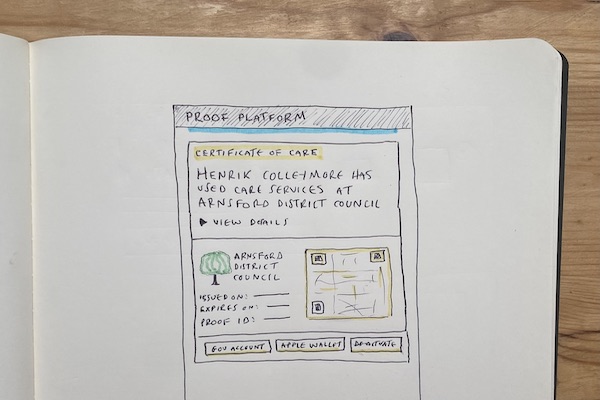
Unburdening people and public services using digital credentials
Imagine if, instead filling out forms to access public services, people were digitally given proof of using one service to show they are entitled to use others. I was reminded of this idea when someone suggested I read the Child Poverty Action Group report on Universal Credit, digitalisation and the rule of law. As one part says:
‘Care leavers and prisoners expecting release, can miss out on entitlement [to Universal Credit] if there is any delay in submitting their claims’.
In an alternative reality, people leaving prison or care would automatically be issued digital certificates proving their status. Then, when they access benefits and other services, people could just show these certificates opposed to completing long and burdensome forms.
Data in people’s hands
Verifiable certificates, digital credentials or ‘digital proofs’ as our team call them, are a recurring theme of our work. To improve digital public services we need to focus a little less on fixing forms, and more on increasing the supply of data that underpins whether they can be automated and accessed by more people.
Recently, our teammates at Neontribe have been working with Alexandra Rose Charity to mint digital vouchers so over 2000 young families get fresh fruit and veg.
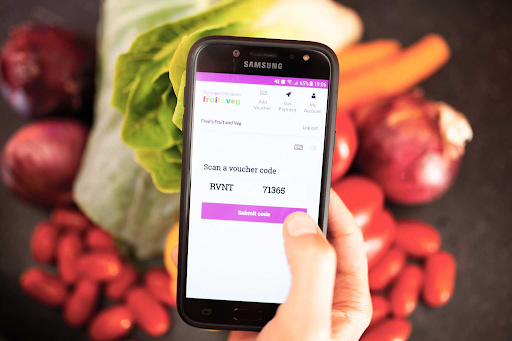
The charity’s fruit and veg service used to rely on manually feeding spreadsheets. They wanted to use technology to reach more families but had limited budgets. They now have vouchers that are distributed and spent both digitally or linked to a printed token. The local fruit and veg sellers are able to get the money redeemed more quickly, and families have more options about how they use the service.
Data sharing across public services is a big topic, so I’ll focus this post on one part – giving public services a tool to mint digital proof. A simple prototype of this idea we showed 4 local councils earlier this year.
But first, a little on what it’s like now to pass data between public services.
A real slog
Data reuse in the public sector may sound a bit dry, but I bet you’ve personally felt the pain of trying to pass information from one public service to another. Logging into a service to download a PDF. Proving your identity to get a share code. Requesting a letter to prove something. Photographing and scanning documents.
Uploading images as part of an application. Sending a document by special delivery. The list goes on.
This video about how to upload documents to apply for free travel in London has been viewed over 100,000 times. This number of people needing instructions on how to upload a document, shows how burdensome it is for people to pass information from one public service to another.
And these ‘admin burdens’ aren’t equally shared. The more public services someone needs, the more they have to prove facts about themselves to access them. For example, families on low incomes have to provide proof when applying and reapplying for services including:
- financial support
- school places
- free school meals
- tax exemptions
- social housing
- childcare subsidies
- help with NHS costs
- cheaper broadband
- discounted TV licences
While a family might ultimately get access to those services, it comes at a high cost to their spare time, emotional space and cognitive load. Again, given their circumstances, they will have less of these things to spare than others.
Passing data between people and public services is a slog for the government too. Printing proof letters on demand. Manually checking uploaded and posted proof letters. Data matching different records. Verifying documents are real. Helping vulnerable people find the right documents. Managing API integration requests. Again, not an exhaustive list.
So what do we do about it?
No big fixes
Before getting on the fun of identifying solutions, it’s important to stress that the automatic passing of data between public services is a hard problem. It’s actually dozens of hard problems. Each with different challenges of technology, legislation, security, budgets, privacy, standards (or lack of them), culture and politics.
Take data matching. It’s blooming hard. As one local authority team told us “even if we were to get this data sent automatically, we’d still have to manually check our systems to see whether someone was already accessing our services.”
This is a long-winded way to say there’s never going to be one big fix to more automated data sharing (or most problems for that matter).
Right — caveats over.
Minting digital proof
You may have seen more governments exploring digital wallets and credentials for public services. Such as the BC Wallet designed by the government in British Columbia, Canada.

These technologies have the potential to help unravel some of the burdens I’ve mentioned. Packaging up data from one service and making it easily reusable by others opens up new designs for public services. And it’s genuinely exciting.
I think there’s a step before the UK public sector adopts digital wallets and credentials – giving public services the capability and freedom to create digital proof for themselves. What if there was a ‘proof platform’ that enabled just that?
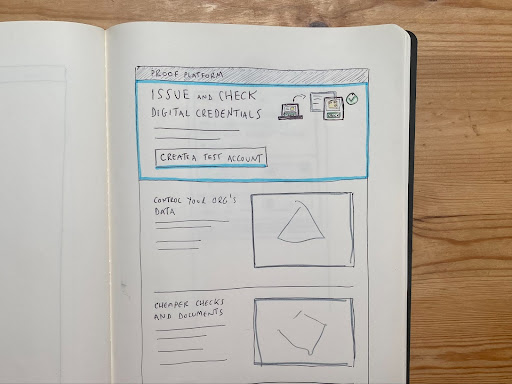
You name it – certificates, letters, permits, awards, entitlements, payments, registrations. Every end-point of a public service could be made into reusable digital proof.
We met a team from another local council. They were tasked with improving the support for young people leaving care. We showed the proof platform prototype and, without prompting, the council team said they could use something like this to speak to other departments in the local authority. They gave the example of their plans to give young care leavers free gym entry. The team could give people proof of having been in care that they can show other parts of the council — in this case, the part that runs leisure centres.
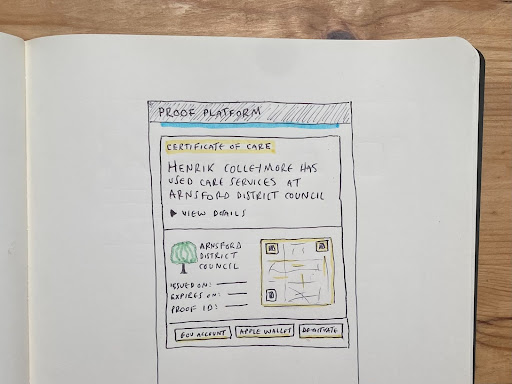
We showed the proof platform prototype to a third local authority. This team was looking at digital services for the whole council. Their reaction highlighted limits to a proof platform idea. Using apply for a taxi licence as an example service, they said digital credentials wouldn’t automate away what they called the “big analog bit in the middle” of digital services. Because their taxi service would still require people to provide 7 different evidence documents. Each piece has to be manually uploaded and checked either side of proprietary software. That’s fiddly and expensive to change. So more digital proof won’t fix everything.
Automation for all?
Digital proof could mean data sharing is opened up to all public sector organisations, not just the ones financially and technically able to make and consume APIs. What’s come out of our conversations so far, is that, with the exception of the large operational departments, most organisations would be limited in being able to use APIs that pass personal data between services.
Years ago, I was lucky enough to work on the same floor as the teams that first developed GOV.UK Notify and GOV.UK Pay. One thing that struck me about their successful adoption was that they didn’t exclude services that couldn’t use APIs. Whether that was allowing 10-year-old versions of Microsoft Excel to be uploaded, or payment pages that URLs can be printed onto a paper form.
Digital proof should be no different. Organisations big and small should be able to freely adopt and benefit from digital proofs. Reaching a level where they’re widespread enough that data flows easily between organisations when people’s needs arise. I’ve done drawings to show what I mean. And used the scenario of someone proving their dog is vaccinated, so they can go abroad.
Level 1 – manually sharing data, human to human
One of the UK’s 4000 vet practices uses the proof platform to create, print and post a dog owner a vaccination certificate. And the owner shows the printed certificate to ferry company staff to scan at a sea port.
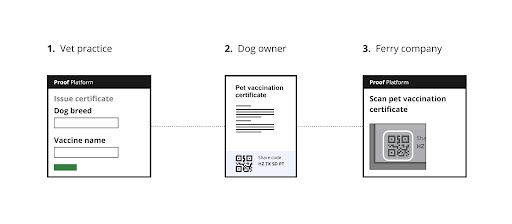
With this manual use of digital proof, smaller, less digitally mature organisations can still make use of data exchange. For a variety of reasons, many people are unable to use a smartphone, app or website, but still need to access services.
Level 2 – semi-automated, human to computer
A vet practice uploads a spreadsheet to the proof platform that lists all the animals they’ve vaccinated that month. This creates, and then emails, hundreds of vaccination certificates to pet owners. So a dog owner enters a certificate ID when booking a ferry online.
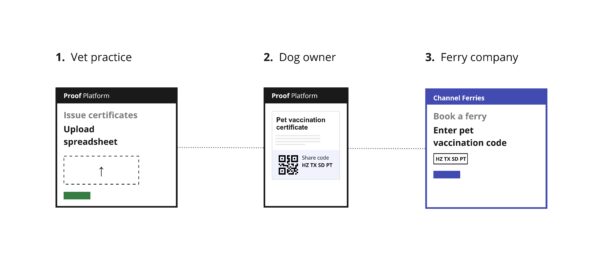
With semi-automated use of digital proof, organisations can share information with each other, while providing fully digital services to a larger number of people. All without necessarily being able to use APIs.
Level 3 – fully automated
A vet practice uses third-party software called VetCase to record what vaccinations it’s given a dog. This automatically sends an API call to the proof platform that creates a digital certificate of the vaccination, that’s linked to the dog’s owner’s contact details. A ferry booking service (with permission) fetches a vaccination certificate using the proof platform API.
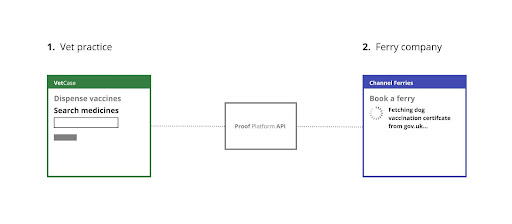
Automated digital proof means services can skip whole burdensome steps for people who use them.
Cheap and cheerful reform
A proof platform is still only a theory of change – that by giving organisations the ability to mint digital credentials, there are far more raw materials needed for automation. Which in turn would mean we can design and build public services that are more human-centred and less burdensome.
The first responses to the prototype have been encouraging. What’s stuck with me the most is the feedback from the local authority team supporting young people leaving care. They were clear that being able to issue digital credentials could make it easier for care-experienced young people to access services. And that credentials could also make it simpler to provide services spanning across the council’s departments. This makes me feel in my gut it’s an idea worth exploring further.
You know, the more I think about it, a proof platform is a cheap way to begin to really reform how data is shared between services. A reform that can be used by services regardless of their size or budget. Moving us on from filling in forms towards automating out the burden of how people, businesses and government interact.
Thanks to Dan Brickley who highlighted that W3C Verifiable Credentials are a great standardisation effort for the underlying technology that such a proof platform system would need.